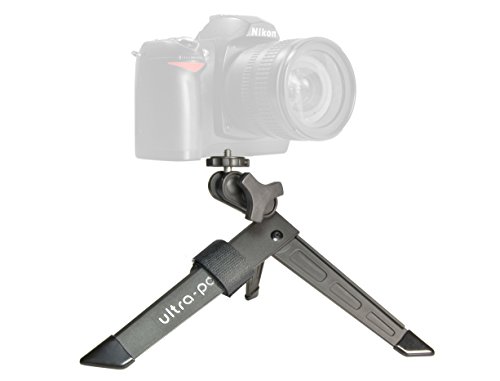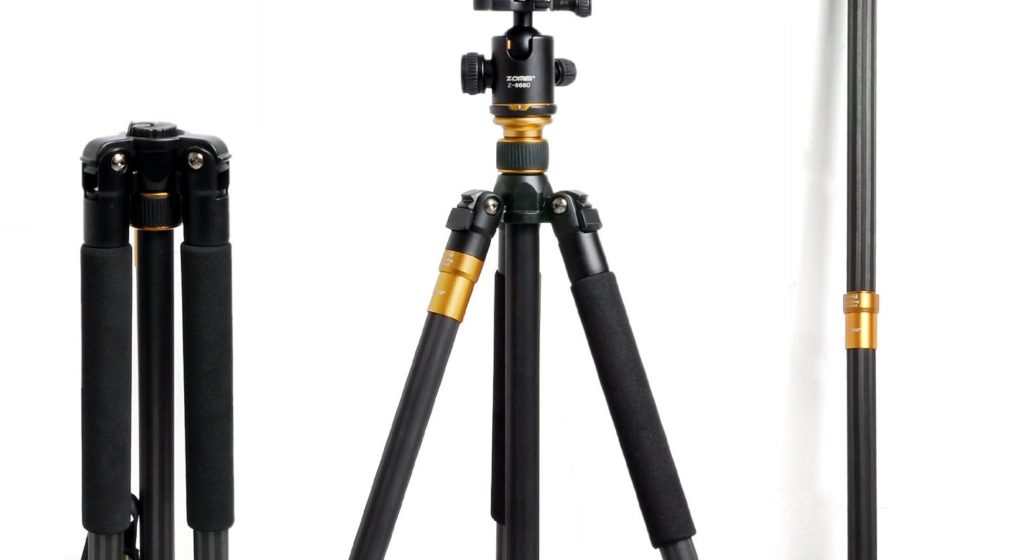
When your passion of hiking and backpacking crosses with photography, things can get tricky.
Any photographer needs a tripod for certain shots, but trekking into the wilderness with this bulky device isn’t always easy.
So, what’s the solution?
More...
We need lightweight and compact tripods for backpacking. They have to be small enough to fit into the pack yet expansive enough to serve as a functional tripod. Plus, we need a steady shooting platform that’s also lightweight. Not a simple proposition.
So, how do we solve these problems? Often backpacking tripods are smaller than regular tripods. Backpackers sacrifice some of the size of a normal tripod in order to save space and weight. We might even pay a little extra for lightweight materials.
What you’ll want to consider first is exactly what your needs will be. If you’re doing macro photography you’ll be able to use a different tripod than landscape photographers, for example.
What you should know before buying a tripod for backpacking
Weight Capacity
DSLRs today are coming bulkier and heavier than ever. If you’re rocking a large DSLR camera with a beefy lens, you need to know its total weight. Why? Because many small tripods can’t handle the weight of large cameras and lenses.
Make sure that your compact backpacking tripod can handle the extra weight of any lenses you’ll be using. Large lenses often make the camera off-balance. This means your tripod needs a large enough base of support to prevent the entire assembly from tipping over.
Tripod Height
Because we’re looking for a tripod that can travel well in our backpacks, we may not be able to accommodate the luxury of a full-size tripod. Normally we would recommend a tripod that is about chin-height so that you can easily operate the camera when standing comfortably. Unfortunately, this means a large and heavy device.
For backpacking, we’ll want to be more selective. Choosing a compact tripod that’s half height or less can be a good way to compromise on saving weight and bulk.
Trekking Pole Monopod
Something to consider, which can help solve all of our backpacking tripod woes, is the hiking pole monopod. Basically, these are regular hiking poles with a standard camera mount screw at the top of the handle.
Because there’s only one leg for support, the camera won’t be nearly as steady as with a tripod. You’ll also have to hold on to the monopod during use. It will, however, help to stabilize the camera from any vertical shift while you take the shot. This might be a good compromise for some folks.
Tripod Legs
Today’s tripods come in many flavors, from budget-oriented steel and aluminum tripods all the way up to super lightweight carbon-fiber models. Spending the extra money to buy a tripod with legs made from a lightweight material such as carbon fiber is almost essential if you’re going to carry it on a backpacking trip.
I highly advise going as lightweight as your budget can manage. If you try to skimp on money and buy a heavier tripod, you’ll be less likely to use it over the long run as it will weigh too much and you’ll just leave it in the closet.
Tripod Feet
Since you’ll be taking your tripod into the wilderness, you’ll need better options than standard tripod feet. Some tripods come with feet that can be swapped out. These provide the most versatility and you’ll be able to use the tripod from the mountains to the dance floor.
My suggestion for outdoor tripod feet is spikes. Some tripods have adjustable feet that can swap between rubber mounts and metal spikes. Metal spikes are really helpful in dirt and mud whereas rubber feet are best for rock and hard ground.
Now, here are the top five packpacking tripods I recommend you check out:
When it comes to lightweight, compact, and portable it’s hard to beat the newest generation of tiny tripods. The Pedco UltraPod II Lightweight Camera Tripod fits in the palm of your hand and weighs only 4oz so it’s a perfect hiking companion. It’s got a safe working load of 6lbs but it’s only about 6″ tall when deployed and the height isn’t adjustable.
Fortunately, however, the camera is mounted to the tripod on a double ball and socket joint. That means you can adjust the angle of the camera in 3-axis planes of motion to get any angle you want. This is ideal for macro photographers or landscape shooters looking for low angle perspectives. If you get creative enough with it, there’s a good chance it’ll solve a lot of your stability needs when hiking.
One thing I love about it is the included velcro strap which makes it easy to secure the tripod and your camera to a small tree. That way you can take advantage of nature’s natural tripods for shots that aren’t so low to the ground!
2) Pedco UltraPod Lightweight Camera Tripod (lighter-weight version)
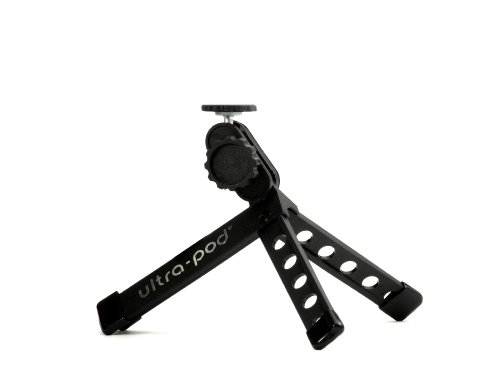
Made by the same manufacturer as the UltraPod II, the lightweight versionmanages to come in at just 2 ounces! This is really the ideal solution for those looking to save every ounce. Just like the slightly larger version, this one has a velcro strap for tree mounting or pole mounting.
It’s a little shorter overall which means better packability but lower shot angles. This could be a really cool way to define your nature shots though. The creative photographer might take advantage of the low camera angle to establish themself as an expert from a low perspective.
Overall, this is the solution for those looking to save weight above all else.
3) Leki Sierra Antishock Trekking Pole
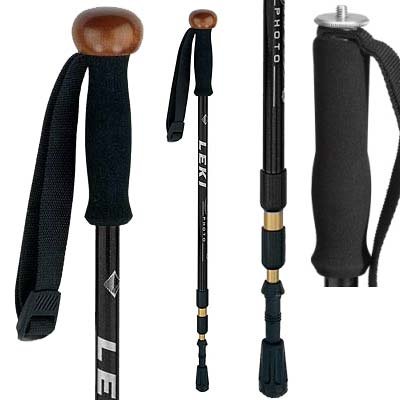
Leki is a well-established hiking and ski pole maker. I owned Leki poles as my very first set of poles and the only beef I’ve ever had with them is being a bit heavy for my tastes. However, the Sierra model trekking pole is a great camera monopod solution for the hiking photographer.
This three section hiking pole is fully adjustable for hiking to fit any body height. When you want to shoot some pictures, just unscrew the wooden knob from the top of the pole. This reveals a standard camera mount screw which you can quickly screw into any camera with a tripod mount attachment.
As we mentioned before, the biggest drawback here is that the monopod is inherently less stable than a tripod. The advantage, however, is that you’ll probably be carrying hiking poles anyways. This way you can have two pieces of equipment in one – a golden rule of backpacking fundamentals!
4) Leki Photosystem Carbon Trekking Pole
If you’re willing to step up in price, the Leki Photosystem Carbonis a three piece flick-lock pole made to maximize features for hiking photographers. I personally like the flick-lock adjustment system over the twist-lock provided in the Sierra model pole.
Why? Because flick-lock is overall a more lightweight system. When combined with the carbon fiber pole body, that makes the Photosystem Carbon pole a much more advanced option for hikers looking to save weight while carrying the best gear for hiking and photography at the same time.
5) ZOMEi Z669C Portable Carbon Tripod Monopod Kit
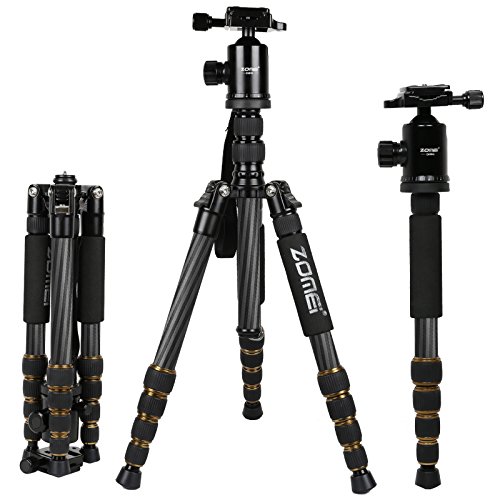
Why did we save the full-size tripod for last? Because it’s a full 3.5 pounds and 15″ long when packed down. Granted, th ZOMEi Z669C is quite small and lightweight for a full-size tripod with sturdy legs and components. The fact remains, however, that it’s pushing the size and weight limits most hikers and backpackers are willing to carry for a tripod.
If you need only the strongest and most robust tripod for your work and you’re willing to carry it into the field, then this one’s for you!
Three twist-lock legs allow the tripod to adjust to full height for comfortable shooting at any height or angle. The 360 degree ball head is flexible but strong enough for beefy camera setups. The quick release plate is pretty much an essential on a full size tripod and you won’t be let down. You’ll even be able to convert it to a strong full-size monopod if you need more mobility away from base camp.

